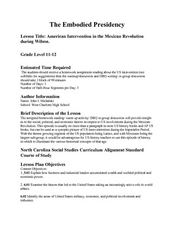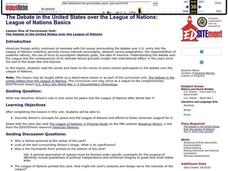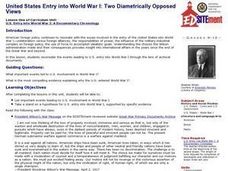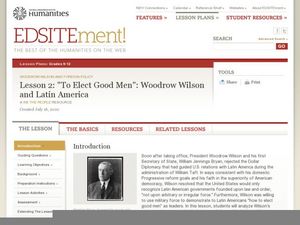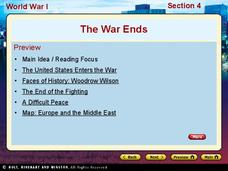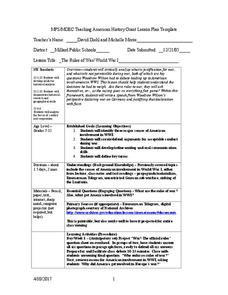National Endowment for the Humanities
“From Time to Time”: Presidents and Communicating with the Public
While the Constitution requires a "State of the Union" address, it doesn't give many details. In fact, it wasn't until Woodrow Wilson that the periodic update to Congress was given in-person. Using primary sources, recordings and...
Curated OER
Woodrow The White House Mouse
Inauguration Day is January 20. Implement an entire week's worth of mini activities to help young historians become knowledgeable of the President's job, the executive branch, and the White House. The worksheets focus on research skills,...
Curated OER
1912: The Election that Changed the Century
The presidential election of 1912 was a turning point in American politics. Whoever won would reshape the political spectrum. Learn about the key issues, each party's politics, and the four men who wanted to become president: William...
Curated OER
President Thomas Woodrow Wilson
In this President Thomas Woodrow Wilson worksheet, students read to assess comprehension skills. In this multiple choice worksheet, students answer seven question.
Curated OER
Woodrow Wilson
In this online interactive history worksheet, students respond to 10 short answer and essay questions about the achievements of Woodrow Wilson. Students may check some of their answers on the interactive worksheet.
Curated OER
Woodrow Wilson
In this online interactive history quiz worksheet, students respond to 50 multiple choice questions about the accomplishments of Woodrow Wilson. Students may submit their answers to be scored.
Curated OER
The Embodied Presidency Wilson
Young scholars take a closer look at U.S. intervention in Mexico. In this 20th century history lesson, students examine primary documents to consider why the United States entered the Mexican War and then write DBQ essays on the topic.
Curated OER
The Debate in the United States over the League of Nations: League of Nations Basics
Students examine Woodrow Wilson's ideas for peace and the League of Nations. They examine how he garnered supported of it by looking at images and discussing their context.
Curated OER
United States Entry into World War I: Two Diametrically Opposed Views
Learners analyze the events leading to U.S. entry into World War I. They read a speech by President Wilson and an opposition speech, list the reasons each gives for American entry into the war, and complete a Venn diagram.
Curated OER
Lesson 2: "To Elect Good Men": Woodrow Wilson and Latin America
Students analyze Woodrow Wilson's foreign policy. In this foreign policy lesson, students examine how the Wilson administration responded to civil unrest in Latin America.
Curated OER
American Presidents 20c
In this matching worksheet, 6th graders match the U. S. president with an act, trial, policy, or event that occurred during his presidency. Students match 25 answers.
Curated OER
Woodrow Wilson: Prophet of Peace
Students read and discuss various speeches by Woodrow Wilson, and write and present a brief radio address that will persuade the nation to return to world peace. Students analyze current events and discuss whether the world has upheld...
Curated OER
Woodrow Wilson
Students practice their reading comprehension skills by reading about Woodrow Wilson. They answer questions about the story to test for comprehension.
Curated OER
Why a President? Why not a King?
Students research how and why a country elects to have an executive branch of the government. They study the office of the Presidency of the US.
Curated OER
20c American Presidents
In this American Presidents learning exercise, students respond to 25 matching questions that require them to match the 25 former Presidents to the appropriate phrases, events, or quotes.
Curated OER
The Debate in the United States over the League of Nations: League of Nations Basics
High schoolers describe Woodrow Wilson's concepts for peace and the League of Nations and efforts to foster American support for it.
National Endowment for the Humanities
The Debate in the United States over the League of Nations: Five Camps: From Voices of Consent to Voices of Dissent
Learners explore and discuss Woodrow Wilson's concepts for peace and the League of Nations. They understand efforts made to foster American support for the League and discuss the opposition shown in the Senate.
Curated OER
Review of our Presidents from the Progressive Era to Cold War
Covering the main events of the Cold War, this (mistitled) presentation includes photographs, political cartoons, and amusing graphics to illustrate its points. The information on the slides is helpful for an overview of the Cold War,...
Curated OER
World War I - The War Ends
Your class is in for a treat with this outstanding PowerPoint on World War I. The presentation is loaded with facts, maps, important personalities, and discussion questions on the war. Additionally, there is a wonderful video called,...
Curated OER
President Woodrow Wilson's Fourteen Points
Ninth graders evaluate President Woodrow Wilson's principle of self-determination and its effects today. In groups, they research how the Great Powers dealt with Korea at the Paris Peace Conference and compare their perspectives with...
Curated OER
The Rules of War/World War I
Students explore the reasons the United States became involved in World War I. In this World History lesson, students research the reasons Woodrow Wilson made the decisions he did, prepare a debate and write a paper.
Curated OER
The Treaty of Versailles: June 1919
There were four key players involved with the Treaty of Versailles. Present information and critical thinking questions regarding Woodrow Wilson, David Lloyd-George, Georges Clemenceau, and Vittorio Orlando. Included also are lists of...
Curated OER
Wilson and American Entry into World War I
Students explore the events that led to American entry into World War I. In this American history lesson plan, students examine the policies of Woodrow Wilson at the dawn of the war, analyze challenges to the neutrality policy of the...
Curated OER
United States Entry into World War I: A Documentary Chronology of World War I
Students identify several important events that led to U.S. involvement in World War I. They examine different explanations, form an opinion about the evidence for each rationale and then create a slideshow to present their findings.








